UPSC Daily Current Affairs: 9th September 2024 | Current Affairs & Hindu Analysis: Daily, Weekly & Monthly PDF Download
GS2/International Relations
SINGAPORE BILATERAL RELATIONS
Source: The Hindu
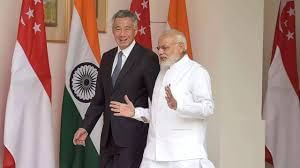
Why in news?
Prime Minister Narendra Modi recently engaged with Singapore's Prime Minister Lawrence Wong to enhance the bilateral relationship between India and Singapore. The leaders agreed to upgrade their ties to a Comprehensive Strategic Partnership, signifying the extensive cooperation between the two nations.
Geographical Context
- Singapore is an island nation and city-state located in maritime Southeast Asia.
- It lies just north of the equator, adjacent to the southern tip of the Malay Peninsula.
- Singapore is bordered by the Strait of Malacca to the west, the Singapore Strait to the south, the Riau Islands of Indonesia to the south, the South China Sea to the east, and the Straits of Johor along with Malaysia's State of Johor to the north.
Historical Context
- Colonial Era: The relationship traces back to 1819 when Sir Stamford Raffles established a trading post in Singapore, which was governed from Kolkata until 1867.
- Post-Independence: Both nations have nurtured strong connections after gaining independence, marked by consistent political dialogue and collaboration.
Economic Relations
- Trade: Singapore ranks among India's largest trading partners, with substantial trade volumes. The Comprehensive Economic Cooperation Agreement (CECA) signed in 2005 has significantly enhanced trade and investment activity.
- FDI: Singapore serves as the largest source of Foreign Direct Investment (FDI) into India, impacting various sectors positively.
Strategic and Defence Cooperation
- Strategic Partnership: In 2015, India and Singapore elevated their relationship to a Strategic Partnership, which strengthened cooperation across diverse fields.
- Defence: The two countries regularly conduct joint military exercises and maintain strong defence connections, focusing on maritime security and counter-terrorism efforts.
Recent Developments
- Comprehensive Strategic Partnership: Recently, the bilateral relationship was further upgraded to a Comprehensive Strategic Partnership.
- MoUs Signed: During their latest meeting, four Memorandums of Understanding (MoUs) were signed in areas including digital technologies, semiconductors, health cooperation, and skill development.
Cultural and People-to-People Ties
- Cultural Exchange: The upcoming inauguration of India’s Thiruvalluvar Cultural Centre in Singapore exemplifies the strong cultural bonds between the two nations.
- Diaspora: A significant number of Indians reside in Singapore, enriching the cultural and economic interactions between the countries.
Geopolitical Significance
- Indo-Pacific Region: Both nations share a mutual vision for a free, open, and inclusive Indo-Pacific region, highlighting the need for peace and stability in the South China Sea.
- ASEAN Relations: Singapore's role as a key ASEAN member is vital, and India’s engagement with ASEAN is essential for its Act East Policy.
GS3/Environment
Plastic Pollution in India
Source: The Hindu
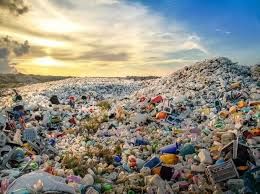
Why in News?
According to a new study, India has secured the top spot as the biggest plastic polluter in the world.
Highlights:
- The study evaluates five major sources of plastic pollution:
- Uncollected waste
- Littering
- Collection systems
- Uncontrolled disposal
- Rejects from sorting and reprocessing
- In 2020, global plastic waste emissions reached 52.1 million tonnes (Mt).
- Notably, 69% of global plastic waste emissions come from just 20 countries, which include:
- 4 low-income nations
- 9 lower-middle-income nations
- 7 upper-middle-income nations
- Littering is the primary source of emissions in the Global North, while uncontrolled disposal is predominant in the Global South.
- Despite generating more plastic waste, high-income countries are not among the top 90 polluters, thanks to their comprehensive waste collection and disposal systems.
Case of India:
- India has emerged as the world's leading plastic polluter, contributing 9.3 Mt of plastic annually, which is about one-fifth of global plastic emissions.
- Plastic emissions are categorized as greenhouse gases (GHGs) that are released throughout the entire lifecycle of plastic, from production to disposal.
- India's reported plastic waste generation rate (approximately 0.12 kilograms per capita daily) is likely underestimated, while waste collection figures may be inflated.
- This discrepancy could be due to:
- Exclusion of data from rural areas
- Open burning of uncollected waste
- Waste recycled by the informal sector
Case of other countries:
- Following India, Nigeria and Indonesia rank second and third in plastic emissions, contributing 3.5 Mt and 3.4 Mt, respectively.
- China, previously identified as the top global polluter, has dropped to fourth place due to significant advancements in waste management, including investments in incineration and controlled landfills in the past 15 years.
Significance of the study:
- This study provides critical insights for the upcoming Global Plastics Treaty, which aims to establish a legally binding agreement on plastic pollution by 2024.
- It offers a new baseline for countries to evaluate and address their plastic pollution, aiding in the development of future action plans and enhancement of waste management strategies.
- However, concerns exist regarding the study's methodology, as it may still underestimate emissions from some high-income countries by excluding plastic waste exports.
Effort to Regulate Plastic Use:
- India - The Plastic Waste Management Amendment Rules (2021):
- In 2022, India implemented the Plastic Waste Management Amendment Rules (2021), which banned 19 categories of single-use plastics, defined as disposable goods made from plastic and generally intended for one-time use.
- Global:
- The United Nations Environment Assembly (UNEA) passed a resolution in 2022 aimed at "ending plastic pollution."
- An Intergovernmental Negotiating Committee (INC) was established to develop a legally binding instrument—a global treaty—to govern plastic production and use globally.
- Global Plastics Treaty:
- In 2022, 175 nations committed to creating a legally binding agreement on plastic pollution by 2024, focusing on reducing GHG emissions associated with plastic production, usage, and disposal.
- Despite extensive discussions and negotiations, the global community appears far from reaching a consensus on effective strategies to combat plastic waste.
GS2/International Relations
FORUM FOR CHINA-AFRICA COOPERATION (FOCAC)
Source: BBC

Why in news?
At the recent Forum on China-Africa Cooperation (FOCAC) summit held in Beijing, China did not fulfill the debt relief requests made by numerous African nations.
Background:
- The Forum for China-Africa Cooperation (FOCAC) was established in 2000 and gained a more significant role following the introduction of President Xi Jinping's Belt and Road Initiative (BRI) in 2013.
About Forum on China-Africa Cooperation (FOCAC)
- FOCAC serves as a multilateral platform aimed at enhancing cooperation and partnership between China and African nations.
Member Countries:
- FOCAC includes China and 53 African nations, with the exception of Eswatini, which recognizes Taiwan. The African Union (AU) is also a participant.
Objectives:
- Economic Cooperation: Aiming to boost trade, investment, and infrastructure initiatives.
- Aid and Development: China offers loans, aid, and developmental support to African countries.
- Political Cooperation: FOCAC encourages multilateral collaboration on global governance issues.
- Cultural and Educational Exchanges: Encouraging mutual understanding through student exchanges, training programs, and cultural interactions between China and Africa.
- Peace and Security: China supports African endeavors to maintain peace and security, providing assistance in conflict zones, UN peacekeeping, and military cooperation.
Criticisms and Challenges:
- China aims to leverage FOCAC to counter increasing competition in Africa from the United States, the European Union, Japan, and other global players.
- Debt Trap Diplomacy: Critics contend that Chinese loans could create a dependency on debt, with worries that some African nations may find it difficult to repay these loans, potentially surrendering control of vital assets.
- Labor and Environmental Concerns: There are apprehensions regarding the employment of Chinese labor for construction projects instead of local African workers, along with environmental issues associated with certain Chinese-led initiatives.
- Lack of Transparency: Some analysts have pointed out the opaque nature of the terms surrounding Chinese loans and agreements, raising issues of governance and accountability in FOCAC-related endeavors.
GS3/Environment
Uncommon Cyclones in the Arabian Sea
Source: Economic Times

Why in news?
This article discusses the unique characteristics of the North Indian Ocean, particularly focusing on the unusual cyclones that have developed in the Arabian Sea, influenced by climate change and monsoonal patterns.
Background (Context of the Article)
- The North Indian Ocean significantly influences weather patterns in India, especially during the summer monsoon, providing essential moisture for rainfall.
- Despite its critical role, this region experiences fewer cyclones than other global ocean basins.
- This article examines the distinctive nature of the North Indian Ocean, the effects of climate change on it, and recent cyclone developments.
Why is the Indian Ocean Unique?
- The Indian Ocean is distinguished by its complex climatic interactions, connecting with the Pacific and Southern Oceans through unique oceanic pathways.
- Warm waters from the Pacific and cooler waters from the Southern Ocean create varied sea temperatures, which affect monsoon winds and cyclone formation.
Monsoonal Influence on Cyclogenesis
- Before the monsoon, both the Arabian Sea and the Bay of Bengal warm significantly, fostering atmospheric convection that leads to rainfall and low-pressure systems.
- However, these systems seldom develop into cyclones due to a phenomenon known as vertical shear, which diminishes the cyclones' strength during the monsoon season.
Impact of Climate Change on the Indian Ocean
- Climate change is altering the dynamics of the Indian Ocean, with rising temperatures from the Pacific and shifts in atmospheric conditions causing rapid warming within the ocean.
- This warming trend is affecting monsoon patterns and increasing the frequency of extreme weather events.
- Cyclogenesis, the process of cyclone formation, occurs under favorable atmospheric and oceanic conditions.
The Role of the Indian Ocean in Global Warming
- The Indian Ocean acts as a key player in global ocean warming, influencing other oceans, including the Pacific and North Atlantic.
- As temperatures rise, this has a cascading effect on ocean currents, altering global climate patterns and directly impacting cyclone unpredictability.
Cyclone Seasons in the North Indian Ocean
- The North Indian Ocean has two distinct cyclone seasons, which is atypical compared to other global regions that usually have only one.
- During the pre-monsoon season, cyclone activity in the Arabian Sea is low due to cooler water temperatures and limited convection, while the Bay of Bengal remains active.
Cyclones in the Arabian Sea and Bay of Bengal
- Generally, the Arabian Sea experiences fewer cyclones than the Bay of Bengal, primarily due to lower convective activity, higher wind shear, and cooler sea temperatures post-monsoon.
- While cyclone numbers in the Bay of Bengal have been stable, the Arabian Sea has seen a slight increase in cyclone activity since 2010, despite a recent calm period.
Cyclone Asna
- Cyclone Asna, which formed in August 2023, was notable as the first cyclone in the North Indian Ocean for that month since 1981.
- What set it apart was its origin from a land-based low-pressure system, which typically occurs over the Bay of Bengal and generates heavy monsoon rains.
- After moving into the Arabian Sea, this system evolved into a full cyclone.
Unusual Nature of Asna
- The transformation of the land-based low-pressure system into a cyclone was unexpected, as it gained strength over the warming Arabian Sea, driven by global warming and local weather patterns.
- Ultimately, Asna weakened due to dry desert air infiltrating its circulation.
The Broader Impact of Climate Change on Cyclones
- Climate change is rendering cyclones in the Indian Ocean increasingly unpredictable, with factors like global warming, El Niño, and underwater volcanic activity contributing to extreme weather phenomena worldwide.
- The monsoon season itself has become more erratic, leading to unpredictable rainfall patterns across India.
Conclusion
- The Indian Ocean is pivotal to many climate change-related phenomena, particularly regarding cyclones.
- While it is less cyclone-prone than other regions, the growing unpredictability of these storms due to climate change poses significant challenges for India and its neighboring countries.
- As climate change continues to impact global weather patterns, understanding and predicting these shifts is crucial for mitigating their effects on vulnerable populations.
GS2/Governance
PRADHAN MANTRI SCHOOLS FOR RISING INDIA (PM-SHRI)
Source: Indian Express
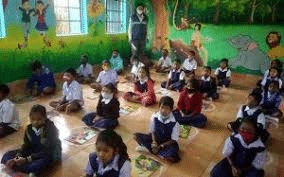
Why in news?
Following financial pressures, the AAP government in Delhi has agreed to sign a Memorandum of Understanding (MoU) with the Central government to implement the Pradhan Mantri Schools for Rising India (PM-SHRI) scheme. This decision comes after the Education Ministry halted funding under the Samagra Shiksha Abhiyan (SSA) for Delhi, Punjab, and West Bengal due to their initial refusal to participate in the PM-SHRI scheme.
About PM-SHRI Scheme
- The PM-SHRI is a centrally sponsored initiative launched by the Government of India.
- The scheme aims to establish over 14,500 PM-SHRI Schools, which will be managed by the Central Government, State/UT Governments, local authorities, Kendriya Vidyalaya Sangathan (KVS), and Navodaya Vidyalaya Samiti (NVS).
- The primary objective is to foster an inclusive and supportive environment for all students, ensuring their well-being and providing a safe, enriching educational setting.
- These schools are designed to offer a variety of learning experiences, ensuring students have access to quality infrastructure and necessary resources.
- Focus areas include cognitive development and the nurturing of well-rounded individuals equipped with essential 21st-century skills.
- The teaching methods in PM-SHRI Schools will be experiential, holistic, integrated, and will emphasize play-based learning, especially in early education.
- The approach will be inquiry-driven, discovery-oriented, learner-centered, and will prioritize enjoyable learning experiences.
- Assessment methods will be based on conceptual understanding and real-life application, focusing on competencies rather than rote memorization.
- PM-SHRI Schools are intended to exemplify the implementation of the National Education Policy 2020 over time.
Current Issue
- States are required to confirm their involvement in the PM-SHRI scheme by signing an MoU with the Education Ministry.
- Currently, Tamil Nadu, Kerala, Delhi, Punjab, and West Bengal have not yet signed the MoU. Both Tamil Nadu and Kerala have shown interest, while Delhi and Punjab initially resisted, leading to the withdrawal of their SSA funds.
- Delhi and Punjab expressed concerns about the PM-SHRI scheme, citing their own initiatives like Schools of Specialised Excellence and Schools of Eminence, which they believe serve similar purposes.
- Punjab was the first to resolve the impasse on July 26, with the Education Secretary communicating their willingness to implement the scheme.
- On September 2, Delhi also indicated its readiness to sign the MoU to establish PM-SHRI schools.
- West Bengal remains the last state yet to agree, opposing the inclusion of "PM-SHRI" in the names of its schools, particularly as the state contributes 40% of the funding.
GS2/Polity
PUBLIC ACCOUNTS COMMITTEE (PAC)
Source: The Hindu
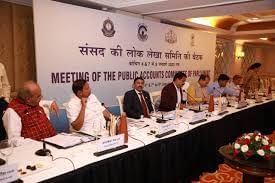
Why in news?
The Public Accounts Committee (PAC) is gearing up to evaluate the performance of regulatory bodies established by Acts of Parliament, specifically focusing on the Securities and Exchange Board of India (SEBI) and the Telecom Regulatory Authority of India (TRAI). The assessment will aim to determine how effectively and efficiently these organizations fulfill their designated roles.
About Public Accounts Committee (PAC)
- The PAC is one of three Financial Parliamentary committees; the other two are the Estimates Committee and the Committee on Public Undertakings.
- These committees operate under the authority granted by Article 105, which pertains to the privileges of Parliament members, and Article 118, which gives Parliament the power to regulate its procedures and conduct of business.
Establishment:
- The Public Accounts Committee was established in 1921, following its initial reference in the Government of India Act, 1919, known as the Montford Reforms.
- Each year, the PAC is constituted under Rule 308 of the Rules of Procedure and Conduct of Business in Lok Sabha.
Appointment:
- The Chairman of the PAC is appointed by the Speaker of the Lok Sabha.
- Since the PAC is not an executive body, its decisions are advisory in nature.
- The committee is made up of 22 members: 15 are elected by the Lok Sabha Speaker and 7 by the Rajya Sabha Chairman, serving a term of one year.
- Ministers are prohibited from becoming members of the PAC, ensuring the committee remains impartial in its oversight of government operations.
Key Functions of the PAC:
- Examine Appropriation Accounts: The PAC reviews accounts that detail how the funds granted by Parliament are utilized for government expenditures.
- Audit Reports: It scrutinizes reports from the Comptroller and Auditor General (CAG) regarding government spending, as well as various audit findings concerning revenue, expenses, and the accounts of autonomous bodies.
- Financial Oversight: The PAC ensures public funds are allocated and used efficiently, checking for any discrepancies or deviations from the approved budget.
- Review of Savings and Excesses: The committee investigates discrepancies that lead to savings due to incorrect estimations or procedural errors and examines any expenditures exceeding the budget.
- Accountability: It holds government departments responsible for their financial management, ensuring expenditures align with the demands approved by Parliament.
- Recommendations: The PAC offers suggestions for improving financial management and accountability, proposing measures to address any identified irregularities.
GS2/Governance
NATIONAL FOOD SECURITY ACT (NFSA), 2013
Source: The Hindu
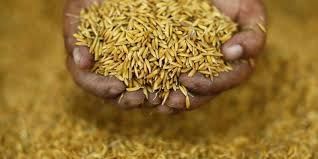
Why in news?
The National Food Security Act (NFSA), 2013, has brought significant changes to the Public Distribution System (PDS) in India. The Public Distribution System (PDS) is a crucial component of India’s food security framework.
About National Food Security Act (NFSA), 2013
- The National Food Security Act (NFSA), enacted in 2013, is pivotal legislation in India that aims to guarantee food and nutritional security for its citizens.
- Food and Nutritional Security: The NFSA ensures that individuals have access to an adequate supply of quality food at prices that are affordable, thereby promoting food and nutritional security.
- Human Life Cycle Approach: The Act addresses various stages of life, including provisions specifically for children, pregnant women, and lactating mothers.
Coverage
- Rural and Urban Population: The Act is designed to cover up to 75% of the rural population and 50% of the urban population, ensuring that a substantial portion of the population benefits from subsidized food grains.
- Priority Households and Antyodaya Anna Yojana (AAY): Beneficiaries are classified into Priority Households (PHH) and AAY households. PHH households are entitled to receive 5 kg of food grains per person per month, while AAY households get 35 kg of food grains per household per month.
Entitlements
- Subsidized Food Grains: The Act mandates the provision of food grains at highly subsidized rates: rice is available for ₹3 per kg, wheat for ₹2 per kg, and coarse grains for ₹1 per kg.
- Nutritional Support: Special provisions are made for pregnant women, lactating mothers, and children, which include maternity benefits and access to nutritious meals.
Implementation
- Public Distribution System (PDS): The NFSA is executed through the Targeted Public Distribution System (TPDS), which is tasked with distributing food grains to eligible households.
- The Food Corporation of India (FCI) plays a crucial role in procuring food grains from farmers at Minimum Support Prices (MSP). The FCI is responsible for the storage and transportation of these food grains to different states.
- State governments facilitate the distribution of food grains through a network of Fair Price Shops (FPS), ensuring that eligible households receive their entitlements.
- Grievance Redressal: The Act establishes mechanisms for addressing grievances at both district and state levels to handle complaints and ensure accountability.
- Legal Entitlement: The NFSA transforms existing food security programs into legally enforceable entitlements, ensuring that eligible individuals have a right to receive food grains.
- Transparency and Accountability: Initiatives such as the digitization of ration cards and online tracking of food grain distribution have been introduced to enhance transparency and mitigate corruption.
GS3/Economy
INDIA’S STEEL SECTOR
Source: Business Standard
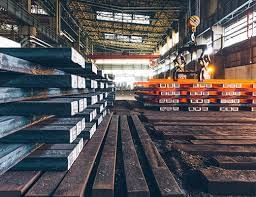
Why in News?
Commerce and Industry Minister Piyush Goyal recently asked the steel industry to target 500 million tonnes steel production by 2034.
- The steel industry in India has its origins in the early 20th century with the founding of Tata Steel in 1907, recognized as the first integrated steel plant in Asia. After India gained independence, the sector expanded with the establishment of state-owned steel plants. The liberalization era of the 1990s led to a significant influx of private investment in the industry.
India's Global Standing:
- India ranks as the second-largest steel producer globally, following China.
- In recent years, India's steel production has surpassed 120 million tonnes annually (as of 2022).
Structure and Capacity of the Industry:
- Integrated Steel Plants (ISPs): Large-scale facilities producing steel from iron ore using blast furnaces and basic oxygen furnaces (BOF). These plants handle the entire process from raw material processing to finished steel products. Notable ISPs include SAIL, Tata Steel, JSW Steel, and JSPL.
- Mini Steel Plants: Smaller operations primarily focused on recycling scrap metal using electric arc furnaces (EAF) or induction furnaces (IF). They mainly produce long steel products for construction and local markets.
Contribution to the Economy:
- GDP Contribution: The steel sector contributes approximately 2% to 3% of India’s GDP, serving as a foundational industry with a multiplier effect on construction, manufacturing, and transportation sectors.
- Employment: This sector provides both direct and indirect jobs to millions, encompassing roles in raw material extraction, steel production, and downstream industries.
- Exports: India is a prominent steel exporter, with primary markets in Europe, the Middle East, and Southeast Asia. Conversely, India imports certain specialized steels that are insufficiently produced domestically.
Recent Trends and Developments:
- Growth in Capacity: India's steel production capacity has expanded significantly, with aims to reach 300 million tonnes by 2030, as outlined in the National Steel Policy 2017.
- National Steel Policy 2017: This initiative encourages the domestic steel industry to achieve self-reliance and enhance global competitiveness. Objectives include raising per capita steel consumption to 160 kg by 2030-31 (up from approximately 74 kg currently), positioning India as a global steel production hub, and promoting environmentally sustainable practices.
- Infrastructure Push: The Indian government's commitment to infrastructure development—such as roads, railways, airports, and smart cities—has spurred increased demand for steel.
- Eco-Friendly Production: With rising global demand for sustainable and low-carbon steel, Indian steel manufacturers are investigating green steel production techniques. This includes hydrogen-based steelmaking, emission reductions, and greater scrap metal utilization.
- Raw Material Supply: Despite having abundant iron ore resources, India heavily depends on imported coking coal, making the sector susceptible to fluctuations in global prices.
- Environmental Concerns: Steel production is energy-intensive and contributes significantly to emissions, prompting a shift towards adopting cleaner technologies.
- Competition: Indian steelmakers face stiff competition from international producers, particularly from China, which dominates the global steel market.
GS2/Polity
Musharraf’s ancestral land in UP to be auctioned under Enemy Property Act
Source: Indian Express
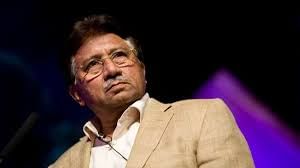
Why in news?
The Indian government is preparing to auction a piece of land in Uttar Pradesh that was previously owned by the family of former Pakistan President Pervez Musharraf. This land, approximately 13 bighas in size, is located in Kotana Bangar village within Baghpat district and is being sold under the provisions of the Enemy Property Act. In connection with this, the Union Home Ministry has issued a notice regarding the land.
Laws dealing with enemy property in India
- Enemy property refers to assets left behind by individuals who moved to countries considered enemies, such as Pakistan and China, particularly after the wars of 1947, 1965, and 1971.
- The Indian government has the authority to seize these properties, denying the heirs of the individuals who migrated any rights to claim them.
- Management of these properties is entrusted to the Custodian of Enemy Property, who is responsible for their sale according to legal guidelines.
Background
- Following the India-Pakistan conflicts of 1965 and 1971, many individuals relocated from India to Pakistan, resulting in the seizure of their properties under the Defence of India Rules, established under the Defence of India Act of 1962.
- These assets were subsequently transferred to the Custodian of Enemy Property for India.
- Similar measures were applied to properties abandoned by those who migrated to China post the Sino-Indian War of 1962.
- The Tashkent Declaration of January 1966 included discussions for the return of such properties between India and Pakistan, but Pakistan sold these properties in 1971, leaving the matter unresolved.
Enemy property in India - Statistics
- Most enemy property consists of land and buildings, alongside some company shares.
- Currently, there are 13,252 enemy properties across India, collectively valued at over Rs 1 lakh crore.
- The majority of these assets belong to individuals who migrated to Pakistan, with over 100 related to those who moved to China.
- Uttar Pradesh has the highest number of enemy properties (5,982), followed by West Bengal with 4,354.
- The central government has initiated a survey to further identify and monetize these properties, many of which have faced encroachment and unauthorized occupancy.
Enemy Property Act of 1968
- This legislation was designed to ensure that properties belonging to individuals or organizations from enemy nations remained under government control.
- Enemy properties are located in various states, including Karnataka, where six valuable properties in Bengaluru are estimated to be worth around ₹500 crore.
Amendment introduced in 2016
- In 2017, Parliament passed the Enemy Property (Amendment and Validation) Bill, which updated the original 1968 Act and the Public Premises (Eviction of Unauthorised Occupants) Act of 1971.
- This amendment expanded the definitions of "enemy subject" and "enemy firm" to encompass legal heirs and successors, even if they are Indian citizens or citizens of non-enemy countries.
- The amended law stipulates that enemy property remains with the Custodian even after the demise, nationality changes, or status alterations of the original enemy owner.
- The Custodian is authorized to sell these properties with government approval and must follow directives from the central government regarding their management and disposal.
Need for such amendments
- The amendments to the Enemy Property Act were introduced to block claims of succession or transfer of properties abandoned by those who migrated to Pakistan and China following the wars.
- The primary aim was to counteract a court ruling that had weakened the Custodian's authority over these properties.
- The Bill's statement of objects and reasons indicated that various court decisions had compromised the Custodian's powers, complicating their ability to act under the original 1968 Act.
Significant legal case regarding enemy property
- A notable case involved the estate of the former Raja of Mahmudabad in Uttar Pradesh. The Raja moved to Pakistan in 1957 and became a Pakistani citizen, while his wife and son remained Indian citizens.
- This situation led to the classification of the Raja's estate, which included valuable properties in Hazratganj, Sitapur, and Nainital, as enemy property.
- After the Raja's passing, his son attempted to claim the properties, and in 2005, the Supreme Court ruled in his favor, triggering a wave of claims from relatives of other migrants wishing to reclaim enemy properties.
- To counter this surge, the UPA government enacted an ordinance in 2010 that prohibited courts from ordering the release of enemy properties, thereby nullifying the Supreme Court ruling and restoring control of the Raja's estate to the Custodian.
- A Bill was subsequently introduced in Parliament but lapsed. Ultimately, the Enemy Property (Amendment and Validation) Ordinance of 2016 was enacted and later became law in 2017, reinforcing government oversight of enemy properties.
GS3/Defence & Security
Responsible use of Artificial Intelligence in war
Source: Indian Express
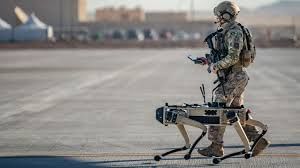
Why in News?
As the military applications of artificial intelligence (AI) grow, there is an increasing need for regulations governing its use in warfare. Recent conflicts, such as those in Ukraine and Gaza, have served as testing grounds for AI technologies in combat scenarios. While India actively promotes the development and safe application of AI in civilian sectors, it has not significantly engaged in global discussions regarding restrictions on military uses of AI. As international frameworks for AI arms control start to emerge, it is essential for India to participate and shape these dialogues instead of remaining passive.
About the summit
The Summit on Responsible Use of Artificial Intelligence in the Military Domain (REAIM) is a part of a wider global initiative to establish norms for military applications of AI. This upcoming summit is the second of its kind, starting on September 9 in Seoul and co-hosted by Kenya, the Netherlands, Singapore, and the United Kingdom.
Objectives of the Korea Summit:
- Assess the effects of military AI on global peace and security.
- Implement new standards for the use of AI systems in military operations.
- Formulate ideas for the long-term governance of AI in the military context.
Outcome of the first summit:
- The inaugural summit took place in February 2023 in The Hague, expanding discussions on military AI, particularly on issues like autonomous weapons, often referred to as "killer robots."
- A significant concern remains the importance of keeping humans involved in decision-making processes regarding the use of force.
- Debates about lethal autonomous weapon systems (LAWS) have been ongoing at the United Nations since 2019.
Increased use of AI in warfare:
- The REAIM initiative has broadened discussions around military AI beyond just autonomous weapons, acknowledging AI's increasing role in various warfare aspects.
- AI has traditionally been used for tasks such as inventory management and logistics, but its application in intelligence, surveillance, and reconnaissance (ISR) has seen significant growth in recent years.
- Leading military forces are now utilizing AI to analyze large data sets, improve situational awareness, expedite decisions on the use of force, enhance targeting accuracy, reduce civilian casualties, and increase the tempo of military operations.
Concerns Over AI in Warfare:
- Despite the anticipated advantages, many critics warn that the appeal of AI in military contexts may be misleading and potentially hazardous.
- The rise of AI decision-making support systems (AI-DSS) is a prominent topic of discussion within the REAIM framework, raising concerns about the ethical implications and risks associated with relying on AI for battlefield decisions.
Promoting responsible use of AI in military affairs:
- The REAIM initiative has shifted focus from attempting to reverse the AI revolution in military affairs to advocating for its responsible application in warfare.
- This is part of several global strategies—national, bilateral, plurilateral, and multilateral—aimed at fostering responsible AI usage.
- At the conclusion of the Hague summit, the United States presented a draft political declaration on responsible AI use, which was formalized in November 2023.
- In 2020, the US issued national guidelines for military AI utilization and encouraged NATO allies to adopt similar frameworks.
- NATO's 2021 strategy outlined six principles for responsible AI usage in military contexts and published relevant guidelines in July 2023 to promote safe and responsible AI deployment in warfare.
- The US is also engaged in bilateral discussions with China to address the implications of AI on nuclear deterrence.
US introduced resolution at the UNGA:
- The US introduced a resolution at the United Nations General Assembly (UNGA), co-sponsored by 123 nations and adopted by consensus.
- While the UN's focus is broad, the REAIM process encourages more detailed discussions about military AI, aiming to build a large international coalition to establish new global norms.
- Over 50 countries have supported the US's initiative for responsible AI use in military contexts, with efforts to connect with Global South nations for additional backing.
India’s stand:
- India has adopted a 'watch-and-wait' strategy regarding this dialogue, carefully assessing the long-term implications without fully endorsing new AI initiatives.
- It did not support the “call to action” at the Hague summit and remains uncertain about backing the global AI framework expected at the Korea summit.
- India risks falling behind if it continues to take a passive role in shaping these vital norms.
- India's negative experiences with nuclear arms control, where reluctance cost it the chance to influence global standards, highlight the importance of engaging during the design phase rather than trying to amend established rules later.
Stand of China:
- China has been proactive, participating in both strategic and regulatory discussions regarding military AI.
- It emphasizes "intelligised warfare" and published a White Paper on military AI regulation in 2021.
- China also supported the Hague summit’s call to action.
|
61 videos|5403 docs|1144 tests
|
FAQs on UPSC Daily Current Affairs: 9th September 2024 - Current Affairs & Hindu Analysis: Daily, Weekly & Monthly
| 1. What are the key features of the National Food Security Act (NFSA), 2013? |  |
| 2. How does the Pradhan Mantri Schools for Rising India (PM-SHRI) scheme aim to improve education in India? |  |
| 3. What impact does plastic pollution have on India’s environment and health? |  |
| 4. What is the significance of the Forum for China-Africa Cooperation (FOCAC) for India? |  |
| 5. How do uncommon cyclones in the Arabian Sea affect regional weather patterns? |  |





















